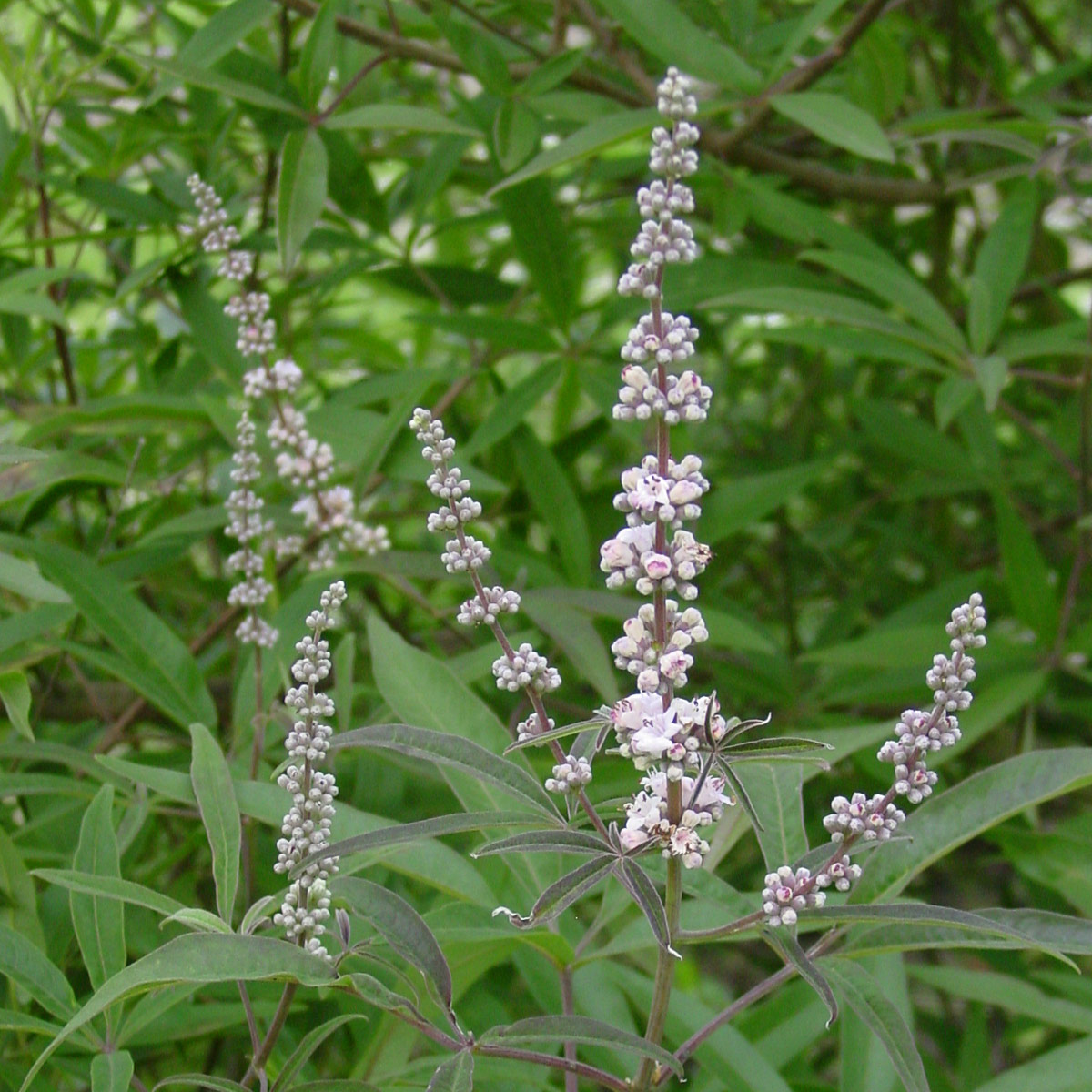Botanical name
Vitex agnus-castus L.
Family
Labiatae (Lamiaceae)
Common name
Vitex, Monk’s pepper, Chaste tree, Chasteberry
Information about the plant
Vitex is a shrub native to the Mediterranean region to western Asia, where it forms dense crops in coastal areas and along rivers. The genus name Vitex (Latin "vitex" = rim, wheel rim, wheel hub) probably comes from the Greek "vitilium" (= wattle) and refers to the use of the tough and hard branches of the shrub to produce wattle fences. The name "Chaste tree" is a literal translation of the epithet agnus-castus (Latin "agnus" = lamb and "castus" = chaste). It is reported that the fruits of this shrub were eaten by monks in monasteries as a sort of anaphrodisiac, in order to suppress carnal lust. This is also indicated in the name "Monk’s pepper" due to the peppery and spicy flavour of the fruit. However, the name is probably the result of a number of misinterpretations of the word.
Vitex is a 3-5 m high shrub, characterized by its large, palmately divided, decussate leaves. Each of the 5 to 7 leaflets is 10 cm long with white hairs on the underside and glabrous on the top surface. The small blue to lilac-coloured fragrant flowers are bilabiate, and spike-like inflorescences are close together on the ends. Flowering time is from September to October. The 4-seeded fruits are reminiscent of black pepper because of their colour (reddish black) and size; they also taste hot. They smell more like sage though.
Medicinally used parts of plants (herbal drug)
The dried fruit (Agni casti fructus) is used. The commercially available drug is collected in the wild and comes mainly from Albania and Morocco.
Constituents of the herbal drug
Vitex fruits contain iridoid glycosides, flavonoids, lipophilic, diterpenes, essential oil and fatty oil.
Quality of the drug
The quality of the following drugs or drug preparations is specified in the European Pharmacopoeia (Ph. Eur.):
- Vitex fruits (Agni casti fructus)
- Vitex fruits dry extract (Agni casti fructus extractum siccum)
Medical applications
Recognised medical use
The HMPC has accepted Vitex fruits in the form of dry extracts (DER 6-12:1, extractant ethanol 60%) as "well-established use". It can be used continuously over 3 months for the treatment of premenstrual syndrome; see also "Traditional use".
ESCOP: for premenstrual syndrome including tenderness and pain in the breasts; also, for menstrual disorders such as too frequent, too few or no periods.
Traditional use
Vitex fruits in the form of powdered drug and tincture (DER 1:5, extractant ethanol 68-70%) or in the form of dry extracts (DER 7-17:1; ethanol 60% and DER 10.0-18.5:1, ethanol 50-52%) has been classified by the HMPC as a traditional herbal medicinal product (Article 16a of Directive 2001/83/EC) based upon long-standing use for the following indication: for the treatment of mild premenstrual complaints. See also "well-established use".
Herbal drug preparations in finished dosage forms
- Dried extract from Vitex fruits in tablets and capsules
- Tincture in drops
- Vitex agnus castus homeopathic mother tincture in drops
Dosage
To ensure the effect, Vitex fruit should be used as a finished medicinal product, the dosage is stated in the patient information leaflet.
Preparation of a tea
Not applicable
Notes
Women with estrogen-sensitive tumors must consult their doctor before treatment with Vitex fruit. This also applies to women taking dopamine agonists, dopamine antagonists, estrogens and antiestrogens (possible interactions), and to women with a history of pituitary gland disorders. In prolactin-producing tumors of the pituitary gland, there is a risk of masking the tumor symptoms.
There is no information on the use of Vitex fruits during pregnancy, it is discouraged during lactation as the milk production may be affected. There are no safety studies on the use in adolescents under 18 years of age and children.
Side effects
Severe allergic reactions with facial swelling, difficulty breathing and swallowing have been observed. Furthermore, skin reactions, headaches, dizziness, gastrointestinal symptoms, acne, and menstrual symptoms (frequency not known) have also been reported.
Interactions
Vitex fruit has a dopaminergic effect, while taking dopamine-receptor antagonists simultaneously may result in a mutual weakening effect.
References
Herbal drug monographs
HMPC (2018), ESCOP (2003), WHO Vol. 4
Further literature
Commentary on the European Pharmacopoeia (Monk's pepper fruit, No. 2147; Monk's pepper fruit dry extract, No. 2309)


